![]()
![]()
![]()
Use LEFT and RIGHT arrow keys to navigate between flashcards;
Use UP and DOWN arrow keys to flip the card;
H to show hint;
A reads text to speech;
18 Cards in this Set
- Front
- Back
|
T or F: Heart provides force that drives blood through blood vessels by creating pressure gradient. |
True |
|
|
Blood pressure |
outward force that blood exerts on walls of blood pressure. Highest in large systemic arteries Lowest in large systemic veins |
|
|
T or F: magnitude of blood pressure gradient is one main factor that determines blood flow (volume of blood that flows per minute) |
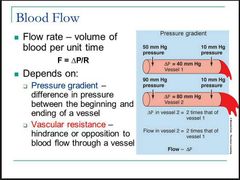
True. Q=change in pressure÷ Resistance |
|
|
T or F: Blood flow is directly proportional to pressure gradient. |
True |
|
|
T or F: generally, blood flow matches cardiac output; averages about 5-6 liters/min |
True |
|
|
T or F: Blood flow is inversely proportional to resistance. |

True |
|
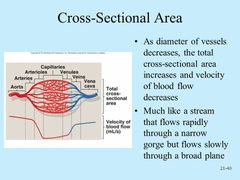
T or F: velocity with which blood flows is largely determined by cross-sectional area of blood vessel. |
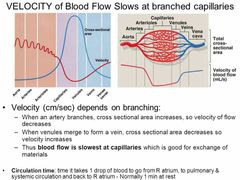
True |
|
|
What are the three main factors that influence blood pressure? |
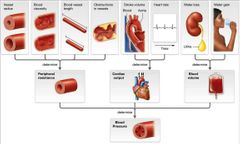
1. Resistance: radius, length, viscosity. 2.Cardiac Output 3.Blood volume |
|
|
T or F: peripheral resistance is directly proportional to blood pressure. |
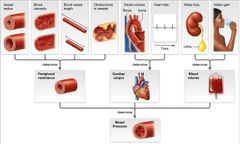
True |
|
|
T or F: The longer the blood vessel, the greater the resistance. More pressure is needed to propel blood through long vessel than short one. One reason why resistancd in pulmonary circuit is so much lower thab in systemic circuit |
True |
|
|
Describe relationship between blood pressure, cardiac output and peripheral resistance. |

Cardiac output and peripheral resistancr are two factors that determine pressure gradient that drives circulation. |
|
|
T or F: Blood pressure is determined by volume of blood in circulation. |
Total volume of blood is directly linked to amount of water in blood. When blood contains more water, blood volume increases. As blood volume increases, blood pressure increases and vice versa. |
|
|
T or F: small increase in blood volume are offset by ability if vessels to stretch (compliance). |
True Veins are most compliant vessels; stretch ti accommodate added fluid when blood volume increases, with only small rise in pressure. |
|
|
T or F: blood pressure remains low throughout pulmonary circuit;however, blood pressure changes significantly as blood travels through systemic circuit. |
Pulmonary circuit BP: 15mmHg Systemic circuit BP: 95mmHg |
|
|
Mean arterial pressure (MAP)
|
average pressure in systemic arteries during entire cardiac cycle; generally about 95mmHg. Heart has both contraction and relaxation periods; so pressure gradient generated by heart pulsates; rises during ventricular systole and declines during ventricular diastole; leads to two separate pressures in arteries. |
|
|
Pulse pressure |
difference between systolic and diastolic pressures. 120-80=40mmHg. |
|
|
Mean arterial pressure formula |
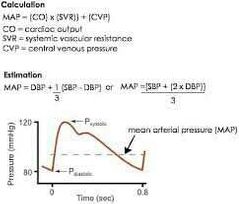
|
|
|
T or F: MAP must be constantly maintained around 95mmHg; any deviation from this set point triggers mechanisms from nervous, endorcine, and urinary systems that act to restore blood pressure to this level. |
True |

